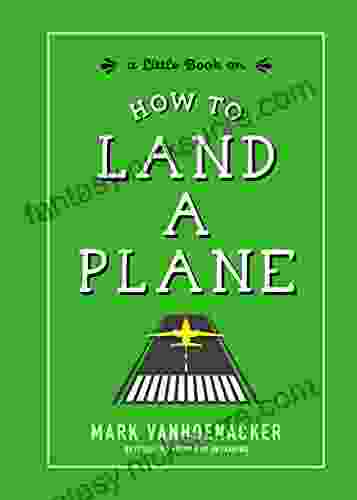The Comprehensive Guide to Landing an Airplane: A Step-by-Step Approach for Pilots

Landing an airplane is a critical skill that every pilot must master. It requires a combination of precision, coordination, and situational awareness. This guide will provide a comprehensive overview of the landing process, from the initial approach to the final touchdown. By following these steps and practicing regularly, pilots can improve their landing skills and increase their safety margin.
Pre-Landing Procedures
Before initiating the landing procedure, pilots must prepare by:
4.3 out of 5
| Language | : | English |
| File size | : | 7726 KB |
| Text-to-Speech | : | Enabled |
| Screen Reader | : | Supported |
| Enhanced typesetting | : | Enabled |
| Word Wise | : | Enabled |
| Print length | : | 64 pages |
| Lending | : | Enabled |
- Briefing the landing: Review the landing checklist, verify the runway conditions, and calculate the approach speed and flaps setting.
- Configuring the aircraft: Extend the landing gear, set the flaps, and trim the aircraft for the approach.
- Establishing the approach: Align the aircraft with the runway centerline and establish a stable approach path at the correct speed and descent rate.
The Approach
The approach is the most critical phase of the landing process. Pilots must maintain a stable flight path and monitor their airspeed and altitude closely.
- Stabilized approach: The aircraft should be flying at a constant speed and descent rate, with the wings level and the pitch attitude maintained.
- Visual cues: Pilots should use visual cues, such as the runway lights and horizon, to judge their descent and maintain a proper glide path.
- Instrument guidance: In low-visibility conditions, pilots can rely on instrument guidance, such as the ILS or GPS, to maintain a precise approach.
The Flare and Touchdown
The flare is the transition from the approach to the touchdown. As the aircraft approaches the runway, the pilot gradually reduces the descent rate by gently pulling back on the yoke or control wheel.
- Judgment and timing: The pilot must judge the correct height and pitch attitude for the flare and execute it smoothly.
- Roundout: The aircraft should level off just above the runway and gradually slow down as it enters the roundout phase.
- Touchdown: As the aircraft loses lift, the main wheels gently contact the runway.
Rollout and Braking
After touching down, the pilot must maintain directional control and slow the aircraft to a safe taxi speed.
- Directional control: The pilot should steer the aircraft using rudder and ailerons to maintain the runway centerline.
- Braking: The pilot should apply brakes gradually to slow the aircraft. The amount of braking pressure will depend on the runway conditions and the aircraft's weight.
- Taxiing: Once the aircraft has slowed to a safe speed, the pilot can exit the runway and taxi to the parking area.
Common Errors in Landing
Even experienced pilots can make errors during landing. Some of the most common errors include:
- Floating: Approaching the runway too high or at an excessive speed, resulting in a long or hard landing.
- Balloon flare: Pulling back too early or too aggressively during the flare, causing the aircraft to balloon above the runway.
- Drifting off the runway: Losing directional control during the rollout and drifting off the runway centerline.
- Hard landing: Contacting the runway too abruptly, causing damage to the aircraft or injury to its occupants.
Tips for Improving Landing Performance
To improve their landing skills, pilots can:
- Practice regularly: The more landings a pilot performs, the better they will become at it.
- Analyze landings: After each landing, take time to reflect on your performance and identify areas for improvement.
- Use simulators: Flight simulators can provide a safe and controlled environment to practice landings.
- Seek instruction: A qualified flight instructor can provide valuable feedback and instruction to help pilots improve their landing technique.
Landing an airplane is a complex but rewarding skill that requires precision, coordination, and situational awareness. By following the steps outlined in this guide, practicing regularly, and seeking feedback when needed, pilots can improve their landing performance and increase the safety of their flights.
alt="Airplane landing" title="An airplane landing on a runway." src="airplane_landing.jpg">
4.3 out of 5
| Language | : | English |
| File size | : | 7726 KB |
| Text-to-Speech | : | Enabled |
| Screen Reader | : | Supported |
| Enhanced typesetting | : | Enabled |
| Word Wise | : | Enabled |
| Print length | : | 64 pages |
| Lending | : | Enabled |
Do you want to contribute by writing guest posts on this blog?
Please contact us and send us a resume of previous articles that you have written.
 Fiction
Fiction Non Fiction
Non Fiction Romance
Romance Mystery
Mystery Thriller
Thriller SciFi
SciFi Fantasy
Fantasy Horror
Horror Biography
Biography Selfhelp
Selfhelp Business
Business History
History Classics
Classics Poetry
Poetry Childrens
Childrens Young Adult
Young Adult Educational
Educational Cooking
Cooking Travel
Travel Lifestyle
Lifestyle Spirituality
Spirituality Health
Health Fitness
Fitness Technology
Technology Science
Science Arts
Arts Crafts
Crafts DIY
DIY Gardening
Gardening Petcare
Petcare Terry Pratchett
Terry Pratchett Gary Kamiya
Gary Kamiya Jakub Marian
Jakub Marian Clifford A Pickover
Clifford A Pickover Hilary Nangle
Hilary Nangle Vernon G Zunker
Vernon G Zunker Gianna Sobol
Gianna Sobol Betsy Herman
Betsy Herman Holly Donahue Singh
Holly Donahue Singh Sara Low
Sara Low Gail Fay
Gail Fay Melissa Abramovitz
Melissa Abramovitz Jackie Brown
Jackie Brown Brandon Sanderson
Brandon Sanderson Ted Kaczynski
Ted Kaczynski Jeremy Paxman
Jeremy Paxman Bryan Mann
Bryan Mann Mark Young
Mark Young Paul Halpern
Paul Halpern David Price
David Price Chris Sims
Chris Sims Joe Byers
Joe Byers Robert F Burgess
Robert F Burgess Kevin Sverduk
Kevin Sverduk Tony Ortega
Tony Ortega Jane Bottomley
Jane Bottomley J D Gauchat
J D Gauchat Dinah Bucholz
Dinah Bucholz Dick Edie
Dick Edie Pedro Urvi
Pedro Urvi John C Norcross
John C Norcross Jane Nelsen
Jane Nelsen Charles Duhigg
Charles DuhiggR E S
 David Halberstam
David Halberstam Charles Simpson
Charles Simpson Rod Powers
Rod Powers William F Keegan
William F Keegan Gavin Weightman
Gavin Weightman Marcus Brotherton
Marcus Brotherton Dave Pine
Dave Pine Suzannah Rowntree
Suzannah Rowntree Paul Francis
Paul Francis Larry Baush
Larry Baush Wanza Leftwich
Wanza Leftwich Ofer Gal
Ofer Gal Laurence Price
Laurence Price Bill Moeller
Bill Moeller Russ Harris
Russ Harris Dan Yaccarino
Dan Yaccarino Sharmila Desai
Sharmila Desai Doug Fletcher
Doug Fletcher Jeffrey Lindsey
Jeffrey Lindsey Jacques Devore
Jacques Devore Erin Mcrae
Erin Mcrae Rebekah Nathan
Rebekah Nathan Adiba Jaigirdar
Adiba Jaigirdar Sang H Kim
Sang H Kim Maggi Savin Baden
Maggi Savin Baden Richard Holmes
Richard Holmes Robert Axelrod
Robert Axelrod Dawn Huebner
Dawn Huebner Sara Dyer
Sara Dyer Sanford Holst
Sanford Holst Bev Pettersen
Bev Pettersen Dawn Hadley
Dawn Hadley John H Holland
John H Holland Christian Smith
Christian Smith Joshua Foer
Joshua Foer Diana Wynne Jones
Diana Wynne Jones Oscar Nilson
Oscar Nilson Katie Singer
Katie Singer Davi Kopenawa
Davi Kopenawa C D Holmes Miller
C D Holmes Miller Billy Griffiths
Billy Griffiths Callum Roberts
Callum Roberts Bob Glover
Bob Glover Tom Dodd
Tom Dodd Joseph Edminister
Joseph Edminister Joan Roughgarden
Joan Roughgarden Kristopher Martel
Kristopher Martel Brian Crist
Brian Crist Izzy Judd
Izzy Judd Cj Andersen
Cj Andersen Ross Edgley
Ross Edgley Gregg Jackson
Gregg Jackson Leah Day
Leah Day Paul Levy
Paul Levy Al Walsh
Al Walsh David Joyce
David Joyce Helen Clarke
Helen Clarke Ryan Johnston
Ryan Johnston Charlotte E English
Charlotte E English David Nirenberg
David Nirenberg Bill Gladstone
Bill Gladstone Karyn D Hall
Karyn D Hall Hayley Mitchell Haugen
Hayley Mitchell Haugen Mark Lehner
Mark Lehner Ezekiel Eversand
Ezekiel Eversand Robert Bruce Thompson
Robert Bruce Thompson Steven M Levy
Steven M Levy Henry Charles Lea
Henry Charles Lea John Kettle
John Kettle Fred H Croom
Fred H Croom Robert Byron
Robert Byron Carlos Torres
Carlos Torres Sandra Davidson
Sandra Davidson Megan Mcgrory Massaro
Megan Mcgrory Massaro Zoe Hana Mikuta
Zoe Hana Mikuta Bill Nowlin
Bill Nowlin J Robert King
J Robert King Pete Spencer
Pete Spencer Manoj Sharma
Manoj Sharma Kristin N Spencer
Kristin N Spencer Marc Bona
Marc Bona Lucas Bessire
Lucas Bessire Kevin C Kelleher Md Md
Kevin C Kelleher Md Md Shantel Silbernagel
Shantel Silbernagel Marion Zimmer Bradley
Marion Zimmer Bradley Yau Ming Ng Thompson
Yau Ming Ng Thompson Vukota Boljanovic
Vukota Boljanovic Dan Murphy
Dan Murphy Valeria Ray
Valeria Ray Simon Pridmore
Simon Pridmore Mary Griffith
Mary Griffith Blake Sebring
Blake Sebring Dylan Tomine
Dylan Tomine Pat Cohen
Pat Cohen Rabbi Jason Sobel
Rabbi Jason Sobel Mike Westerfield
Mike Westerfield Bill Patton
Bill Patton Deborah J Rumsey
Deborah J Rumsey H P Lovecraft
H P Lovecraft Christopher Banecks
Christopher Banecks Rick Steves
Rick Steves Louis Sachar
Louis Sachar Robert A Pelcovits
Robert A Pelcovits Harlan Coben
Harlan Coben Paul Bellow
Paul Bellow Bex Gunn
Bex Gunn Charlie Craven
Charlie Craven The Uk Mathematics Trust
The Uk Mathematics Trust Peter Aitken
Peter Aitken Brad States
Brad States Bob Duff
Bob Duff Editors Of Sports Illustrated
Editors Of Sports Illustrated Elizabeth King
Elizabeth King Yossi Ghinsberg
Yossi Ghinsberg Irene Mceachen
Irene Mceachen Martin Davies
Martin Davies Jake Jacobson
Jake Jacobson John Muir Laws
John Muir Laws Simon Buxton
Simon Buxton Lee Gutkind
Lee Gutkind Dan Blanchard
Dan Blanchard T Edward Nickens
T Edward Nickens Supersummary
Supersummary Wendy Doniger
Wendy DonigerMax Youngquist
 Shelby Mahurin
Shelby Mahurin Jarrett Dapier
Jarrett Dapier Jonathan Crichton
Jonathan Crichton Margo Armstrong
Margo Armstrong Stanislas Dehaene
Stanislas Dehaene Bob Duchesne
Bob Duchesne Steven Hassan
Steven Hassan Joshua Becker
Joshua Becker Bill Gutman
Bill Gutman John Brierley
John Brierley Jitendra Chouksey
Jitendra Chouksey Paula Yoo
Paula Yoo Robert P Beebe
Robert P Beebe James P Allen
James P Allen Michael D Alessio
Michael D Alessio Sheridan Anderson
Sheridan Anderson Michael Lempert
Michael Lempert Marsha Vanwynsberghe
Marsha Vanwynsberghe Michael J Epstein
Michael J Epstein Charles A Rhodus
Charles A Rhodus Ingrid Chalufour
Ingrid Chalufour Matt Parker
Matt Parker Richard Rohr
Richard Rohr Jamie Dumas
Jamie Dumas Dina Nayeri
Dina Nayeri Tiffany Loggins Psyd
Tiffany Loggins Psyd Megan Don
Megan Don Mark Solms
Mark Solms General
General Herschel Knapp
Herschel Knapp Ian Tuhovsky
Ian Tuhovsky Dr Julissa Hernandez Nd Cnhp
Dr Julissa Hernandez Nd Cnhp Bill Miller
Bill Miller Shannon Sovndal
Shannon Sovndal Sandi Mann
Sandi Mann Ta Nehisi Coates
Ta Nehisi Coates R E Skibiski
R E Skibiski Kenny Dill
Kenny Dill Justin Lichter
Justin Lichter George Mahood
George Mahood Marilee Lebon
Marilee Lebon Andrea Cremer
Andrea Cremer Silvia Dunn
Silvia Dunn Hugh Neill
Hugh Neill Stephen L Morgan
Stephen L Morgan Karen Armstrong
Karen Armstrong Ron Elbe
Ron Elbe Lynette Rushton
Lynette Rushton Marisa Imon
Marisa Imon Patrick Mcginty
Patrick Mcginty Steve Schwartz
Steve Schwartz Linda D Dahl
Linda D Dahl Matt Doeden
Matt Doeden James Patterson
James Patterson Steve Biddulph
Steve Biddulph Jen Castleberry
Jen Castleberry Susan M Orsillo
Susan M Orsillo Richard Post
Richard Post Phil Robertson
Phil Robertson Sandra Berenbaum
Sandra Berenbaum Sophia Freeman
Sophia Freeman Jennifer Kolari
Jennifer Kolari Claudia Mazzucco
Claudia Mazzucco Krista Tippett
Krista Tippett Bill Bennett
Bill Bennett Frederica Relly
Frederica Relly Holger Schutkowski
Holger Schutkowski Kent Hrbek
Kent Hrbek Alan Lawrence Sitomer
Alan Lawrence Sitomer Eric H Cline
Eric H Cline J T Williams
J T Williams Mark Vanhoenacker
Mark Vanhoenacker Jessica Wiebe
Jessica Wiebe Bryan Irwin
Bryan Irwin Daniel J Velleman
Daniel J Velleman Sue Enquist
Sue Enquist Jeff Wheeler
Jeff Wheeler Styrling Strother
Styrling Strother Jessica Taylor
Jessica Taylor Claire Russell
Claire Russell S W Wilcox
S W Wilcox David Benjamin
David Benjamin Rupert Spira
Rupert Spira Donncha Hanna
Donncha Hanna Fiona Danks
Fiona Danks Carson Sievert
Carson Sievert Kindle Edition
Kindle Edition Gary Dean Quesenberry
Gary Dean Quesenberry Joy Hakim
Joy Hakim Luciano Floridi
Luciano Floridi Rocky Mcelveen
Rocky Mcelveen Jamie Foxx
Jamie Foxx Stephen Arterburn
Stephen Arterburn Isabel Fonseca
Isabel Fonseca Morgan Oostra
Morgan Oostra Dan Hamilton
Dan Hamilton Elsevier
Elsevier Joseph Campbell
Joseph Campbell Kasey Edwards
Kasey Edwards John Mccannon
John Mccannon Holly Jackson
Holly Jackson Michael Matthews
Michael Matthews Richard B Pelzer
Richard B Pelzer Elizabeth Winthrop
Elizabeth Winthrop Frank Giampaolo
Frank Giampaolo Karen Palacios Jansen
Karen Palacios Jansen Elizabeth A Stanley
Elizabeth A Stanley Henry Nicholls
Henry Nicholls Colin Thubron
Colin Thubron Rachael Scdoris
Rachael Scdoris Ernest Raymond
Ernest Raymond Freddie Fernandez
Freddie Fernandez Cheryl Marlene
Cheryl Marlene Clement Salvadori
Clement Salvadori Enzo Tonti
Enzo Tonti Herbert Dorsey
Herbert Dorsey Vanessa Lapointe
Vanessa Lapointe Dashka Slater
Dashka Slater Peter Jackson
Peter Jackson Erin Mckittrick
Erin Mckittrick Dan Garner
Dan Garner Evan Purcell
Evan Purcell Felicity Aston
Felicity Aston Stephan A Hoeller
Stephan A Hoeller Wendy Hinman
Wendy Hinman Gwendoline Smith
Gwendoline Smith Fodor S Travel Guides
Fodor S Travel Guides P J E Peebles
P J E Peebles G William Barnard
G William Barnard Linda Bauer
Linda Bauer Mindy Mcginnis
Mindy Mcginnis Emma Cannon
Emma Cannon Mike Gibson
Mike Gibson Leland Chant
Leland Chant Curt Sampson
Curt Sampson George C Thomas
George C Thomas D C Haenlien
D C Haenlien Ken Venturi
Ken Venturi Daniele Benedettelli
Daniele Benedettelli Chris Ferrie
Chris Ferrie Sharon Bergen
Sharon Bergen Heather Long
Heather Long Jon Loeliger
Jon Loeliger Marie Max House
Marie Max House Simon Baron Cohen
Simon Baron Cohen Sheila Mackechnie Murtha
Sheila Mackechnie Murtha Marty Gitlin
Marty Gitlin Tony Guerra
Tony Guerra Max Help Workbooks
Max Help Workbooks Michael Tlanusta Garrett
Michael Tlanusta Garrett Doug Scott
Doug Scott Mike Veny
Mike Veny Zigzag English
Zigzag English Jackie Bolen
Jackie Bolen Bharath Ramsundar
Bharath Ramsundar Meagan Trayler
Meagan Trayler Rough Guides
Rough Guides Jamie Aten
Jamie Aten John Mccollister
John Mccollister Elliot Kay
Elliot Kay Bjorn Kiggen
Bjorn Kiggen Laura Nowlin
Laura Nowlin Mark Booth
Mark Booth Edwin H Friedman
Edwin H Friedman Mercedes Lackey
Mercedes Lackey Nicole R Taylor
Nicole R Taylor Paris Williams
Paris Williams James Alexander Currie
James Alexander Currie Yakima Canutt
Yakima Canutt Diondre Mompoint
Diondre Mompoint Scarlett Curtis
Scarlett Curtis Jojo Siwa
Jojo Siwa Rick Reilly
Rick Reilly Melissa Layne
Melissa Layne Victoria Johnson
Victoria Johnson Zecharia Sitchin
Zecharia Sitchin Zach Schonbrun
Zach Schonbrun Elizabeth Thompson
Elizabeth Thompson Farah Heron
Farah Heron Craig Chappelow
Craig Chappelow Stacie Mahoe
Stacie Mahoe Bill Hammack
Bill Hammack Gary Player
Gary Player Kiera Cass
Kiera Cass Joann Cianciulli
Joann Cianciulli Ellen Schuthof Lesmeister
Ellen Schuthof Lesmeister Kevin Marx
Kevin Marx Greg Witt
Greg Witt Eric A Weiss Md
Eric A Weiss Md Virginia Smith Harvey
Virginia Smith Harvey Neil D Jespersen
Neil D Jespersen Dean Keith Simonton
Dean Keith Simonton J Douglas Faires
J Douglas Faires Billy Martin
Billy Martin T Whitmore
T Whitmore David E Stuart
David E Stuart Carl B Tolman
Carl B Tolman Nrup Parikh
Nrup Parikh Zane Grey
Zane Grey Gary Nicol
Gary Nicol Zavonda Vinson Parrish
Zavonda Vinson Parrish Phoebe Bailey
Phoebe Bailey Bill Streever
Bill Streever Thomas Bailey
Thomas Bailey Bill Karwin
Bill Karwin Colleen Graves
Colleen Graves Tim Weston
Tim Weston Sam Harris
Sam Harris Jacqueline B Persons
Jacqueline B Persons Richard W Fisher
Richard W Fisher Chris Sajnog
Chris Sajnog Helen Irlen
Helen Irlen Jennifer Shannon
Jennifer Shannon Nancy Romita
Nancy Romita Joie Jager Hyman
Joie Jager Hyman Jacques Steinberg
Jacques Steinberg Special Tactics
Special Tactics Marie Viljoen
Marie Viljoen Michael Volkmar
Michael Volkmar Michael Hartman
Michael Hartman Shawn Levy
Shawn Levy Manly P Hall
Manly P Hall Jedd K Parkinson
Jedd K Parkinson Cherie Dimaline
Cherie Dimaline Susan Shelby Torrance
Susan Shelby Torrance Scott Wilson
Scott Wilson Tiffany Bergin
Tiffany Bergin Max Lugavere
Max Lugavere Douglas W Ota
Douglas W Ota Kate Marchant
Kate Marchant Robert Greene
Robert Greene Ginger Sinsabaugh
Ginger Sinsabaugh Pat Drake
Pat Drake Peter Julius Sloan
Peter Julius Sloan James R Payne
James R Payne Jim Greenwood
Jim Greenwood James Dashner
James Dashner Jessica Denay
Jessica Denay Stephanie Manley
Stephanie Manley Rachel Burgess
Rachel Burgess Ian Wilson
Ian Wilson Rob Casey
Rob Casey Deborah Blum
Deborah Blum Kate Darling
Kate Darling Chris Napier
Chris Napier Phil Genova
Phil Genova Bill Boyum
Bill Boyum Laurie Rubin
Laurie Rubin Anya Kamenetz
Anya Kamenetz Charles Goodwill
Charles Goodwill Paul Brummell
Paul Brummell Sarah Zettel
Sarah Zettel Thomas Cleary
Thomas Cleary Dr Nancy L Nolan
Dr Nancy L Nolan Rob Steger
Rob Steger Thad Beery
Thad Beery Genius Reads
Genius Reads Mosby
Mosby Curvebreakers
Curvebreakers Issai Chozanshi
Issai Chozanshi Conway X Bowman
Conway X Bowman Matthew Bowling
Matthew Bowling Kasun Indrasiri
Kasun Indrasiri Brienne Murk
Brienne Murk Tom Humphrey
Tom Humphrey Aylette Jenness
Aylette Jenness James W Finegan
James W Finegan Sue L Hamilton
Sue L Hamilton Rachna Chhachhi
Rachna Chhachhi Ramona Finn
Ramona Finn Tina Cassidy
Tina Cassidy Lisa Dorfman
Lisa Dorfman Michael J Tougias
Michael J Tougias Michael Sullivan
Michael Sullivan Ross Bonander
Ross Bonander David E Johnson
David E Johnson Olivia Gordon
Olivia Gordon Janice Selekman
Janice Selekman Beck Weathers
Beck Weathers Emma Griffin
Emma Griffin Frank S Ring
Frank S Ring Tara Bianca
Tara Bianca Michael W Eysenck
Michael W Eysenck Jon M Sweeney
Jon M Sweeney Kat Kruger
Kat Kruger Erin Beaty
Erin Beaty Jelena Bogdanovic
Jelena Bogdanovic Bill Schneider
Bill Schneider Carlos Castaneda
Carlos Castaneda Sabaa Tahir
Sabaa Tahir Blaine Bartel
Blaine Bartel Jared Derksen
Jared Derksen Editors Of Garden And Gun
Editors Of Garden And Gun Martyn Denscombe
Martyn Denscombe Chris Fischer
Chris Fischer Bode Miller
Bode Miller Carolyn Schulz
Carolyn Schulz Geraldine Van Bueren
Geraldine Van Bueren Henry M Cowles
Henry M Cowles
Light bulbAdvertise smarter! Our strategic ad space ensures maximum exposure. Reserve your spot today!

 Percy Bysshe ShelleyThe Ultimate Companion for Parents: Guiding Your Little Ones Along the Path...
Percy Bysshe ShelleyThe Ultimate Companion for Parents: Guiding Your Little Ones Along the Path... Boris PasternakFollow ·14.1k
Boris PasternakFollow ·14.1k Gil TurnerFollow ·18.8k
Gil TurnerFollow ·18.8k Anton ChekhovFollow ·13.6k
Anton ChekhovFollow ·13.6k Evan HayesFollow ·5.9k
Evan HayesFollow ·5.9k Derek BellFollow ·15k
Derek BellFollow ·15k Dalton FosterFollow ·11.5k
Dalton FosterFollow ·11.5k Robert Louis StevensonFollow ·15.5k
Robert Louis StevensonFollow ·15.5k Ian McEwanFollow ·14.1k
Ian McEwanFollow ·14.1k

 Sammy Powell
Sammy PowellBalancing Your Hormones Naturally: Regaining Fertility...
Hormones play a vital role in our...

 Kendall Ward
Kendall WardThe Other Baby Book: A Comprehensive Guide to Baby's...
The Other Baby...

 Kenneth Parker
Kenneth ParkerA Comprehensive Guide to Yoga Sadhana for Mothers:...
Motherhood is a...

 Neil Parker
Neil ParkerInside the Secret Space Programs
An Exposé...
4.3 out of 5
| Language | : | English |
| File size | : | 7726 KB |
| Text-to-Speech | : | Enabled |
| Screen Reader | : | Supported |
| Enhanced typesetting | : | Enabled |
| Word Wise | : | Enabled |
| Print length | : | 64 pages |
| Lending | : | Enabled |














